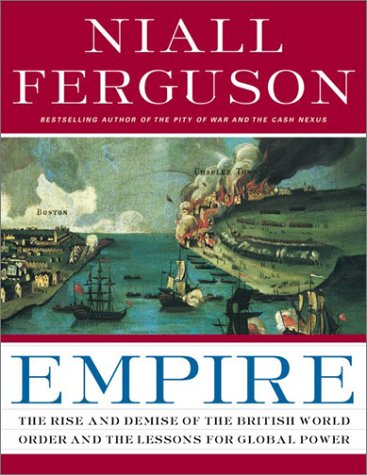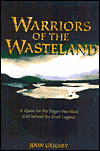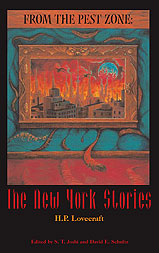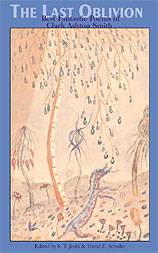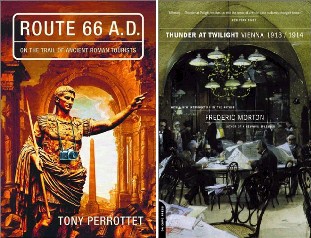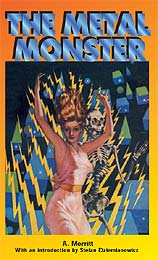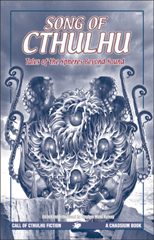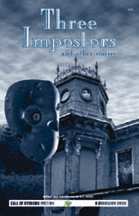|
Lost Civilizations Uncovered
|
|
Book Reviews Archive
EMPIRE ** 1/2 (out of four) Reviewed May 2003 Oxford historian Niall Ferguson has become something of a celebrity in recent weeks,
garnering rave reviews for his new book Empire: The Rise and Demise of the British World Order and the Lessons for Global
Power. The book was originally subtitled "How Britain Made the Modern World" for its British release, but both that and
the cover art were revised for the American version. Reviewers from all the corners of the media landscape gushed about Ferguson's
"revolutionary work" that was "extensively researched and analytical" even if many disagreed with his premise: that, on balance,
the British Empire was a good thing for those that lived under it. Nevertheless, many of the articles praising Ferguson's
lessons for American power seem to have forgotten to read the 350 pages which lie between the introduction and the conclusion,
the only two places where the "lessons for global power" are discussed. More interesting by far was Ferguson's recent New
York Times Magazine piece directly discussing America's imperial role and comparing it with Britain. Ferguson presents a superficial history of the British Empire, from its beginnings
in 16th century privateering expeditions to harass Spain to its rapid decolonization in the 1950s and 60s. With quick prose
and silver-tongued sentences, he speeds through the major events of imperial glory and imperial shame, never dwelling more
than a few paragraphs on any one thing. Arguably, he had to go quickly to capture 400 years of history in under 400 pages,
but since the book is double-spaced, presumably there was some room for more prose. He nevertheless manages to provide a fairly
even-handed view of history, telling both the positive and negative effects of British rule. On the plus side there was the
rule of law, economic prosperity, and political stability. On the negative side, there was also racism, violence, and oppression.
For Ferguson, the balance favors the positive role of Empire, measured largely in economic terms. If it was good for capitalism,
it was good for all the Empire's citizens. Yet something seems off about this book. Something seems to be missing, a layer of
insight and depth that would truly distinguish this from any other lavishly-illustrated coffee table book. Compared to other
works from the past decade on imperial topics, like Thomas Pakenham's The Scramble for Africa (1991) or David Fromkin's
A Peace to End All Peace (reissued 2001), Empire lacks the kind of insight that goes beyond the history-book
timeline approach. Important figures like Queen Victoria make only a cameo appearance in the book, while her son Edward is
omitted from the history altogether. Ferguson, rather than providing character sketches or insight into the protagonists of
his tales, instead discusses which imperial figures were gay and how they enjoyed having sex (like his claim that Lawrence
of Arabia enjoyed being raped by Turkish guards). Also out of the history is Hong Kong, most of the 19th century arms race,
the defeat of Napoleon, or even a reasonable description of the industrial revolution and its impact on the average Briton.
Analysis, when offered, is confined mostly to the introduction and conclusion. Empire's chief virtue is also its
cheif failing: it provides a concise history of the Empire without any of the detail and depth that academic books might risk.
It reads like a television script, unsurprizing since the book came out of a British TV series of the same name, and it retains
too much of the picture-show quality of its electronic original. For those who have never learned of the time when Britian
ruled the world, this is a useful introduction. But since the book has been targeted at those who wish to draw lessons about
America's future role, there is little in the book that is new. If you want to know what all the commentators are making a
fuss about, read the first few pages and the last few. The story in between has almost nothing to do with them at all.
WARRIORS OF THE WASTELAND John
Grigsby Watkins
| 1-84293-058-3 | January 2003 | 242 pages | $19.95 ***
(out of four) Reviewed
May 2003 While
reading John Grigsby's new book on the search for the legend behind the Holy Grail, you will likely have the following three
thoughts: 1. Grigsby is absolutely right. 2. He is absolutely wrong, and 3. He might be right about some things. Depending
on the reader, these thoughts might come in any order. Grigsby,
a former research assistant to alternative historian Graham Hancock, is responsible for the unproven theory that the temples of Cambodia's Angor Watt site form an image of the constellation
Draco as it appeared in 10,500 BC. Now in Wariors of the Wasteland he attacks a more mainstream subject, searching
for the pagan cult of human sacrifice that he believes forms the origin of the legend of the Holy Grail. Grigsby traces the
Grail myth back in time, linking aspects of the story to the Celtic myths he believes gave rise to the tale. He also ties
the mythic journey to the mummified bog men of northern Europe, wonderfully preserved after 2000 or more years. Grigsby believes
that the mysterious manner of their deaths hints that they were reenacting the primal myth of an ancient religion, one that
worshipped the dying and rising gods of the Neolithic. Here,
of course, we run into some of the weaknesses in Grigsby's argument. He claims that the secret lunar cult of the dying and
rising god survived from its extinction at the end of the Neolithic (c.2700 BC) to its putative resurrection around the time
of the Roman invasion of Britain some 2600 years later. How this was done, he can only speculate unconvincingly. Drawing on
the Aryan invasion theory, Grigsby postulates that the lunar cult gave way to the sun-worshipping Aryans, but that their religion
of masculine reason and light destroyed humanitys primal connection to the dark and feminine. Therefore, he believes the mystery
rites of both Classical religion and the druids were designed to restore the pre-Aryan faith by questing for the lunar god
the Aryan solar warriors had killed. Therefore, the Holy Grail is nothing more than the vessel that imparts the knowledge
of the unconscious and the mystical mind. But here is another weakness.
His argument resides solely in his interpretation of the Celtic myths, preserved only in the guise of medieval poems written
some 1500 years after the fact. These, he wants us to believe, preserve in salvageable form ancient thinking. But his ordering
of the myths as preserving three separate strands (lunar, solar, and the return to lunar) rests on his ability to demonstrate
that these stories were composed in the order of his proposed history. This he fails to do, but he hides the fact well by
only occasionally making reference to the vast range of dates (2700 BC-AD 1400) over which he draws his material. He has no
answer to the obvious question: does the continuation of a story mean a continuation of the beliefs behind it? After all,
if Buffy the Vampire Slayer draws a weapon from a stone, that does not mean she is reenacting the medieval Christianity that
animated the Arthur story, only that she borrowed a motif for its mythic quality.
FROM THE PEST ZONE: THE NEW YORK STORIES ** (out of four) The editors of From the Pest Zone never seemed to really pull the book
together or decide exactly what it was going to be, and this is evident right when the reader opens the cover. While the beautiful
red and green cover art (by Sean Madden) presents a haunting vista and the cover design triumphantly proclaims the subtitle
as The New York Stories, the interior cover opines that the true subtitle is instead Stories from New York.
This is a small but telling point. This book is unsure of what it is. S.T. Joshi and David E. Schultz have tried to pull together a volume describing
H.P. Lovecraft's "New York exile," the two-year period when the Providence author was in residence in New York, a city he
came to loathe. The goal, From the Pest Zone tells us was to "show how Lovecraft came to terms with America's only
true megalopolis." I can see how they tried to do that, but for all but hard-core Lovecraft specialists (who know this stuff
anyway), the result is less than satisfying. The two editors open the volume with a lengthy introduction that is substantively
a reworking of information from Joshi's biography H.P. Lovecraft: A Life. They provide an elementary description and
light analysis of the five stories that comprise Pest Zone's middle section. In essence, they say that Lovecraft's
poverty and bad experiences with the multiethnic masses of New York influenced him to write fiction that reflected his loathing
of the city. Yet too much space is spent reproducing Lovecraft's letters and correspondence in voluminous detail without incorporating
them effectively into the awkward introduction. Again, the introduction reinforces the book's split personality. The introduction
tries to be both biography and literary analysis. The two ideas never come together and the essay is confusing and obscure
for readers not intimately familiar with the material (and thus in no need of repetition). The main section of the book is made up of the five stories Lovecraft wrote
during his New York period. These include "The Shunned House," "The Horror at Red Hook," "He," "In the Vault," and "Cool Air."
All of these stories are familiar to Lovecraft fans and can be had at half the price in other editions with plenty more (and
better) stories. Therefore, the reason one would read this book would be for the extensive annotation that the two editors
provide for the stories. However, while Pest Zone promises "exhaustive notes to each story, supplying information on
their background, history," etc., more than half the notes are definitions of words in the stories culled from the pages of
the Oxford English dictionary. Most of the rest are an address book for place names used in the stories. Some lengthy ones
probe the origins of the stories' themes and offer comparisons. The notes cannot decide whether they are a dictionary service
or literary analysis. More duality. But my biggest beef with the book is that it never came together. The three
sections (introduction, stories, and notes) do not form a coherent whole. If they wanted to make a good book about Lovecraft's
New York years that combined the best aspects of biography and analysis with the stories themselves, there was a better way.
If the editors had embedded the stories in their biography it would have worked so much better as a true literary achievement.
They should have divided up the introduction/analysis so that each story would be introduced by that part of Lovecraft's biography
that led up to its creation and followed by the analysis of what the reader had just read. Then the sections would be part
of an organic whole. As such, there is nothing new in From the Pest Zone to attract the afficianado of all things Lovecraft,
and it is too confusing and fragmentary to attract new readers.
THE LAST OBLIVION: THE FANTASTIC POEMS OF CLARK ASHTON SMITH *** (out of four) I'm not sure how to review a book of poetry, especially the kind of poetry that Clark Ashton Smith wrote. His meter was as faultless as it was archaic, and his vocabulary numbs the senses. I have never been partial to reading
poetry, and attempting to read almost 200 pages of it was something of a daunting task. Nevertheless, the haunting beauty
of some of the poetry more than met my expectations. To quote from it would be pointless; to excerpt a poem is to destroy
its essence. The Last Oblivion is not the first book of Smith's poetry, but it is the first one that has been widely available to
the public in at least thirty years. It also has the added benefit for fans of weird fiction of providing in one place only
those poems that touch on the strange and the fantastic. Smith is perhaps best known today as a friend of H.P. Lovecraft and the writer of weird and poetic fantasies with names
like "The Abominations of Yondo" or "The Weird of Avoosl Wuthoqquan" set in remote times and places, like medieval France,
prehistoric Hyperborea, or futuristic Zothique. The introduction to the new volume by S.T. Joshi and David E. Schultz tells
us that these tales were mostly written in just five years (1930-1935), but Smith's "devotion to poetry remained constant
from earliest childhood to his final days." Smith wrote much poetry, and The Last Oblivion collects that segment of
it that touches on the same sense of the weird and wonderful that animates Smith's prose. But here is one of the principal troubles with The Last Oblivion. The editors, both "leading authorities on Smith,
H.P. Lovecraft, and their circle" have attempted to cull from Smith's vast body of poetry that which is of greatest interest
to readers of Smith's and Lovecraft's fiction, namely the weird and fantastic. They have arranged the poems in thematic categories
("The Eldritch Dark," "Said the Dreamer," etc.) but they relegated the composition dates for the poems to the back of the
book, so it is hard to get a sense of how Smith's poetry changed over time. A parenthetical date in the text could have helped.
They also provide a glossary of words Smith used which would be unfamilar to casual users of the English language, and they
reprint a (very) few of Smith's fantastic paintings. A couple of extra paintings could have helped break up the density of
the text. Joshi and Schultz caution the reader that Smith's poetry is an acquired taste, and while they believe he ranks as one of
America's greatest poets, they feel that today's scholars unfairly rank it as "esoteric or passe" because it does not
conform to modern expectations. Yet, they fail to notice that Smith wrote from the 1920s to the 1960s, at the height of the
modernist movement, yet chose to compose his poetry in the archaic and ancient styles of the 15th-18th centuries. His mastery
of form and meter is faltless, but it is the faltlessness of the student of the Old Masters. While the book's editors doubt
that "literary merit is somehow equivalent to contemporaneousness,"one would not praise a play written today in iambic pentameter
or music composed for the lyre. Smith's poetry is undoubtably beautiful, elegaic, and haunting, but it is beautiful in the
way that America's Neo-Gothic cathedrals are beautiful. They are a glorious throwback to another Age, but they can never be
truly great because they work within conventions that the great men of times past set. But if you can understand that much,
then this book is a wonderful companion piece to Smith's weird fiction, a kind of Book of Psalms for the Lovecraftian canon.
ROUTE 66 A.D.: ON THE TRAIL OF ANCIENT ROMAN TOURISTS ** (out of four) THUNDER AT TWILIGHT: VIENNA 1913/1914 **** (out of four) Reviewed July 2002 Summer is the traditional time for light reading, time to escape from the angst-ridden world of reality to another time
and another place. Two new books call up the ghosts of other times and other places and resurrect, ever-so-briefly, worlds
that have been and gone: the wonders of the Roman Empire at its height and the decadence of the Austro-Hungarian in its senescence. Tony Perrottet, a world traveler, finally decided to see the Mediterranean after years of visiting less hospitable areas.
Dragging his pregnant wife along for the adventure, he retraces the path of the ancient Roman Grand Tour, visiting the imperial
tourist's favorite destinations, like Naples, Athens, Turkey and Egypt in Route 66 A.D.: On the Trail of Ancient Roman
Tourists. Perrottet's Route 66 A.D. is perhaps the highest-profile history and travel book released this summer, As the title
indicates, the book's jokey, self-effacing style gives it a winsome and breezy charm. Through such chapters as "The Empire
on Ten Denarii a Day" and "Lucian Takes a Sex Tour," the author presents us with a compendium of factoids about Roman tourism
and Roman culture. He compares and contrasts the tourism of yesteryear with that of today. Though his book is chock-full of
little nuggets of information (like the menu of the McDonalds outside Pompeii), the book often feels a little light on its
history and a bit superficial. Complicating matters, Perrottet makes several mistakes in his book, twice confusing A.D. and B.C., thus erroneously making
Homer contemporary with Charlemagne and the emperor Septimius Severus with Classical Greece. In a caption to a photo from
the 1963 movie Jason and the Argonauts, he misidentifies the god Triton as his father Poseidon. Most annoying, he claims,
"In Victorian Britian, they [mummies] became key ingredients of Egyptian gothic horror tales with suggestive titles like The
Mummy's Foot, Some Words with a Mummy, and Imprisoned with the Pharaohs." Needless to say, "Some Words"
was a story by the American author Edgar Allan Poe, and "Imprisoned" was a story by none other than H.P. Lovecraft,
written in the hardly-Victorian date of 1924 for Harry Houdini and appearing under the latter's name. Mistakes aside, Perrottet provides a light and energetic tour through antiquity's wonders, breathing new life into the
Old World. In a similar vein, Frederic Norton's Thunder at Twilight: Vienna 1913/1914 resurrects another world dead
and gone, the declining splendor of Austria-Hungary in the last years of Emperor Franz Joseph. This 1989 work is newly reissued
by Da Capo press with a new afterward by the author. Centering around the events leading up to the assassination of Archduke
Franz Ferdinand, heir to the throne, Thunder masterfully traces the life of a city that played host that year to Hitler,
Lenin, Stalin, Trotsky, Freud, and others who gave birth to the twentieth century in a place that still looked back fondly
on ages past. In words that are sheer poetry, Norton takes us inside the Imperial and Royal Hapsburg Family (the Empire was Dual Monarchy,
so the Hapsburgs were Imperial in Austria and Royal in Hungary). We see that the Archduke Franz Ferdinand was more than the
the man in a feathered hat shot dead. He was a lover who faced disgrace to marry the woman he loved, the woman scandelously
not royal enough to be considered Imperial. He loved peace and fought to stop the inevitable European conflict that his death
would ironically start. We meet the old Emperor in his most of ancient of days, sunning with the actress he loved but refused
to let himself love physically. We sense the glittering pageant of Viennese life and feel sympathy for the unweildy old empire tottering on the verge of
modernity. We see the inevitable slide to war, the way the best of intentions led Austria-Hungary to an ultimatum against
Serbia, whose native sons had conspired to kill the Archduke. We see and recoil at the way the system of alliances that Austria
had devised to make war impossible instead became a suicide pact that made peace unfathomable. The story unfolds with the
rhythm and power and inevitablity of Greek tragedy. In competing views of empires lost, spend a few hours at Twilight rather
than on Route 66. THE METAL MONSTER ** (out of four) Reviewed June 2002 Hippocampus Press came up with an unusual conceit for its new line of books. They publish a line of books reprinting titles
that horror author H.P. Lovecraft owned, read, and loved. Called "From Lovecraft's Library," it promises to offer "the modern
reader" new editions of copyright-free works that were popular around 1920. Lovecraft read voraciously and compiled an essay
called Supernatural Horror in Literature (see below) to detail and rank the best elements of weird fiction. Pointedly,
The Metal Monster is not included. In the story, a certain Dr. Walter T. Goodwin journeys to the Trans-Himalayan region (Tibet), where he bumps into an odd
assortment of his old friends on his quest for some rare flower or another. Why all these people are bumming around a corner
of the earth that the author calls "the unexplored upheaval" is never explained, but our cast of adventurers runs into a lost
race of Persians who decided to hide out from Alexander the Great two thousand years earlier. Along the way, our heroes run into Norhala, a strange woman of the plateau who seems to control powers that are greater
than man. All of this leads us inexorably to the revelation of the Metal City, made up of sentient metal blocks, its strange
cosmic intelligence and its plan to rule where man now rules. The ending is reminiscent of the Norse legend of the Kraken
made metal and is deeply unsatisfying. On the other hand, the novel contains many admirable passages that capture, ever so briefly, the cosmic horror inherent
in an intelligence that is at once greater than humanity and completely indifferent to it: "something utterly uncomprehending,
utterly unconscious of, cosmically blind to all human emotion; that spread itself like a veil over her own consciousness."
Some of the descriptions of the strange phenomena of the Metal City are spectacular, but mostly they are long and difficult
to follow and keep straight. The human characters are unspeakably wooden and lifeless. The metal has more vitality than these
cardboard cut-out characaters. To be fair to Merritt, the author of many fine stories including "The People of the Pit," The Metal Monster is not
all bad. It does, however, have a schizoid personality that forced me to admire the artisit's vision while finding myself
utterly indifferent to the story itself. Much of this is due to the pulp fiction style of the 1920 story first serialized
in Argosy All-Story Weekly. Sentences are typically written backward, with the adverb first, and many exclamation points
at the end: "Swiftly flesh melted back upon him, clothed him!" or "Weird enough was the sight!" It is both tedious and exhausting
to read. Since this book is marketed as a favorite of Lovecraft, I can do no better than let him speak for himself. In 1934 Lovecraft
wrote: "Actually the book contains the most remarkable presentation of the utterly alien and non-human that I have
ever seen. I don't wonder that Merritt calls it his 'best and worst' production. The human characters are commonplace and
wooden --just pulp hokum-- but the scenes and phaenomena!" Merritt went on to revise the story several more times before
the serial was first collected as a 1946 novel, but Merritt still disliked the final copy. The Hippocampus version reprints
the original 1920 serial edition, the one Lovecraft read. Read it for the scenery, but don't expect anything from the characters. THE ANNOTATED SUPERNATURAL HORROR IN LITERATURE **** (out of four) THE SHADOW OUT OF TIME: THE CORRECTED TEXT ** (out of four) Small book publisher Hippocampus Press formed three years ago to publish editions of H.P. Lovecraft and other 1920s and 1930s pulp authors. To that end, they have
put out two annotated editions of Lovecraft, Supernatural Horror in Literature and The Shadow Out of Time. Each
of these works shows Lovecraft at his best, and for the most part the notes by editor and Lovecraft scholar S.T. Joshi enhance
the texts and shed new light on familiar work. In 1927 Lovecraft published Supernatural Horror, an essay detailing the rise of the modern supernatural tale from
its origins in the 18th century Gothic tradition until Lovecraft's own time. Joshi tells us that the essay "has been widely
acknowledged as the finest historical treatment of the field." Joshi also provides this edition with a clever little introductory
essay outlining Lovecraft's theory of weird fiction as the reserve of the intellectual few, which he contrasts with the Steven
King/Clive Barker horror genre as a whole, seen here as "superficial, if lucrative, hackdom." It is Neitzsche's philosophy
applied to literature: only the best minds are worthy of exposure to greatness, the rest should be placated with trash. Of course, Supernatural Horror itself makes up the centerpiece of volume, and it still holds up well on iths 75th
anniversary. Joshi's notes supplement Lovecraft's text, illuminating how the author selected titles for inclusion in his survey
and showing how the books Lovecraft included influenced his own fiction, which would rightly come to be regarded as the culmination
of the evolution of the weird tale. I don't think it is much of a stretch to say that since Lovecraft's death the weird tale
has not emerged much from his shadow. This new edition provides 35 pages of notes and an extensive bibliography of all the
titles referenced in the Supernatural Horror. This is a marked improvement over the 1973 Dover edition where I first
read the essay. Lovecraft opened Supernatural Horror with the immortal line, "The oldest and strongest emotion of mankind is fear,
and the oldest and strongest kind of fear is fear of the unknown." By the time he wrote his last major story, The Shadow
Out of Time, he had employed this universal fear of the unknown to create an immortal vision of an impersonal cosmos that
had no special place for man. In the story, a Miskatonic University professor suffers from a strange mental disease and visions
of a bizarre race of giant creatures from the remote past that seem capable of changing minds with sentient beings of any
time and place. The set up leads to a horrible revelation in the deserts of Australia. Shadow first saw publication in the June 1936 Astounding Stories, but typographic errors and errors in paragraphing
mangled the original text. Now Hippocampus has for the first time published the original Shadow taken directly from
the newly-discovered manuscript as Lovecraft wrote it. But as much as editors S.T. Joshi and David E. Schultz insist that
the "two dozen word changes and the inclusion of six lines of previously omitted text" significantly altered the story, I
can't say that I noticed any of the differences without comparing the new version side by side with the old. I never did find
those missing six lines, and paradoxically the authors say in the introduction that in the 1936 publication "no actual passages
were dropped." But more annnyoing are the footnotes. They are sometimes illuminating but often insult the reader's intelligence. The editors
see fit to footnote most polysyllabic words and offer up Oxford English Dictionary definitions, lest one find Lovecraft's
writing too difficult to understand. They define for us "megalithic," "spectral," "anamolous," and other such high school
vocabulary words. Worst of all, the editors, who spent so much time with the dictionary seem to have spent no time with the
encyclopedia. Some of their notes are flat out wrong. In the most outrageous instance, they tell us that Lovecraft was wrong
to refer to a pre-Inca people since there "is no known civilization in Peru before the Incas." Even the most cursory examination
turns up dozens of spectacular Peruvian civilizations over thousands of years, like the Wari, Moche, and Chimu. Book reviews usually tell you whether a book is worth reading, not whether it is worth buying. But since the Lovecraft
texts are available for free on the internet, it is fair to ask whether Supernatural Horror and Shadow are worth their $15 cover prices. For dedicated Lovecraft
fans, Supernatural Horror is worth the price for the notes and commentary alone, but for the general reader the $5.95
Dover edition (or the free internet one) is all the Supernatural Horror they will ever need. Only people with an abiding
interest in Lovecraft scholarship or textual purity should buy Shadow. For the general reader, any other edition packs
the same punch ($10 will get you 16 Lovecraft tales, including Shadow, from Del Rey), those 24 different words not
withstanding.
|
|
© |
